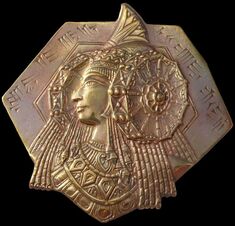
Another Ancient "Lady of Elche" Found In Utah?
The Assyrian[]
 "The Assyrian" bronze medallion |
 |
 |

"The Assyrian", bronze, found in Utah; engraved with Cuneiform
- 𒈫𒌋𒌋, MIN-U-U; (begins right side)
- 𒌑𒄿𒄥𒌋𒀼𒐈, ŠAM-I-GUR-U-M-EŠ5 (right side-middle to end)
- 𒈛𒈫𒀼 (left side)
- Resources
- The Lost Colonies of Ancient America (2013), by Frank Joseph
- Lady of Elche

Profile of Lady of Elche
The Lady of Elche or Lady of Elx is a limestone[1] bust that was discovered in 1897 at L'Alcúdia, an archaeological site on a private estate two kilometers south of Elche, Spain. It is currently exhibited in the National Archaeological Museum of Spain in Madrid. It is generally accepted as an Iberian artifact from the 4th century BCE, although the artisanship suggests strong Hellenistic influences.[2] The originally polychromed bust is thought to represent a woman wearing a complex headdress and large wheel-like coils (known as rodetes) on each side of the face. The opening in the rear of the sculpture indicates it may have been used as a funerary urn.[3]
- Lady of Guardarmar
Another similar artifact associated with Iberian culture is the Lady of Guardamar, which also has similar wheel-like rodetes and necklaces. The Lady of Guardamar (Dama de Guardamar), is a limestone female bust, 50 cm high, dated circa 400 BCE, that was discovered in fragments in the Phoenician archaeological site of Cabezo Lucero in Guardamar del Segura in Alicante province, Spain, on September 22, 1987.[4]
- Resources
- Ancient Origins, https://www.ancient-origins.net/artifacts-other-artifacts/stunning-yet-mysterious-lady-elche-002305
- Anunnaki Queen, http://infinityexplorers.com/enigma-lady-elche-anunnaki-queen
Sammuramāt[]
Sammu-ramat was mentioned by Herodotus, and by the later historian Diodorus Siculus who elaborated a whole legend about her as Semiramis. According to Diodorus, she was born of a goddess, and, after being married to an Assyrian officer, she captivated king Ninus, the founder of Ninevah, by her beauty and valour and became his wife. When Semiramis assumed power, she built Babylon and turned to the conquest of distant lands.[5]
The historical Sammurāmat was a queen regent of Assyria between 811 and 808 BCE.[5] She came into power after the death of her husband, King Shamshi-Adad V in 811 BCE. She ruled the Neo-Assyrian Empire as its regent for five years until her son Adad-nirari III came of age.[5]
Some Assyrian sources have her name spelled as MÍsa-am-mu-ra-mat. Diodurs Siculus rendered the Greek equivalent of her name as Σεμιραμις or Σεμυραμις (II 4.6), and claimed that it meant "dove" in the "Syrian" (or probably Assyrian) language. Her name indicates a derivation from the Akkadian word summatu, or even summu. Rabbinic sages understood her name as šmy rʿm "thunder of heaven". The modern scholar M. Weinfeld suggested a Phoenician background (šmm rmm "high heavens").
Wife of Nimrod[]
Nineteenth-century Scottish minister Alexander Hislop claimed in his book The Two Babylons (1853) that Semiramis was an actual person in ancient Mesopotamia.[6] Hislop believed that Semiramis was a Queen consort and mother of Nimrod, builder of the Bible's Tower of Babel, although biblical mention of consorts to Nimrod is lacking. Hislop believed Semiramis and Nimrod's incestuous male offspring to be the Akkadian deity Tammuz, a god of vegetation, as well as a life-death-rebirth deity. Hislop maintained that all divine pairings in religions, such as Isis and Osiris and Aphrodite and Cupid, are retellings of the tale of Semiramis and Tammuz. Hislop took literary references to Osiris and Orion as "seed of woman" as evidence in support of his thesis. This all led up to Hislop's central claim: that the Catholic Church is a veiled continuation of the pagan religion of ancient Babylon, the product of a millennia-old secret conspiracy founded by Semiramis and Nimrod.[7] Author and conspiracy theorist David Icke incorporates Hislop's claims about Semiramis into his book The Biggest Secret, claiming that Semiramis also had a key role in the Reptilian alien conspiracy that he asserts is secretly controlling humanity.[8]
References[]
- ↑ Template:Cite news
- ↑ Francisco Vives Boix, La Dama de Elche en el año 2000 : Análisis tecnológico y artístico [1].
- ↑ Luxán, Mª P. et al (2011). Human bone ashes found in the Dama de Elche (5th-4th century B.C.) reveal its use as an ancient cinerary urn. Journal of Cultural Heritage vol. 12, issue 3, pp. 310-316.
- ↑ "Archived copy". Archived from the original on 2009-04-13. https://web.archive.org/web/20090413125723/http://www.convega.com/historia/guardamar/historia.html. Retrieved 2013-06-13. Historia Guardamar
- ↑ 5.0 5.1 5.2 Template:Cite encyclopedia
- ↑ Hislop, Alexander. "The Two Babylons". Philologos.org. http://philologos.org/__eb-ttb/default.htm. Retrieved 2013-01-04.
- ↑ Grabbe, Lester L. (1997). Mein, Andrew; Camp, Claudia V.. eds. Can a 'History of Israel' Be Written?. London, England: Continuum International Publishing Group. pp. 27-28. ISBN 978-0567043207. https://books.google.com/books?id=K2hIY_E_ngYC&pg=PA28.
- ↑ David Icke, The Biggest Secret, 52-54